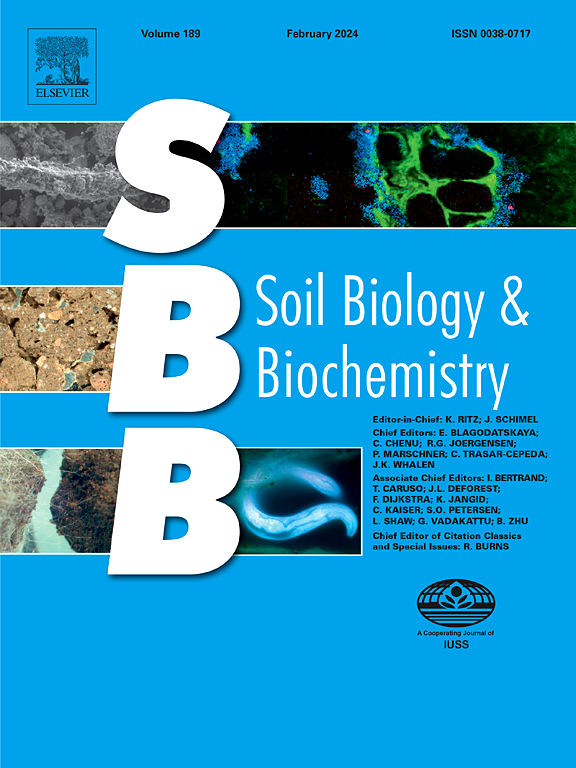驯鹿塑造亚北极沼泽泥炭地的土壤产甲烷和甲烷营养群落,对甲烷排放影响较小--一项实地研究
IF 9.8
1区 农林科学
Q1 SOIL SCIENCE
引用次数: 0
摘要
对其他食草物种的实验室和实地研究表明,在北方泥炭地放牧驯鹿(Rangifer tarandus L.)可能会改变泥炭土壤微生物群落,导致生态系统甲烷(CH4)排放量增加。我们在芬兰北部的两个莎草沼泽(Lompolojänkkä 和 Halssiaapa)进行了这方面的研究,在实验中,驯鹿放牧与否是通过围栏来实现的,并对驯鹿粪便的影响进行了评估,比较了在泥炭表面添加粪便或将粪便踩入泥炭与不添加粪便的对照组。通过元转录组学分析了活跃的土壤甲烷原和甲烷营养群落。土壤中的甲烷通量则通过手动操作室和便携式气体分析仪进行量化。与对照组(无驯鹿或无粪便)相比,驯鹿的存在和粪便的添加都与土壤群落的差异有关。两个沼泽地的反应不同。泥炭中瘤胃微生物的活性无法检测。结构方程模型表明,两个沼泽地生态系统的甲烷通量取决于测量年份和莎草叶面积。在 Halssiaapa 和 Lompolojänkkä,践踏粪便和地表粪便都会减少莎草的叶面积。虽然在哈尔西亚帕,践踏粪便的影响在统计学上并不显著,但在隆波罗耶恩卡,表面粪便直接或通过减少叶面积减少了甲烷通量。总之,驯鹿的存在和粪便的增加在活跃的土壤群落中都有不同的反映,但驯鹿对甲烷通量的影响是间接的,是通过植被介导的。这些结果与我们早先的实验室研究结果形成了鲜明对比,(i) 提醒我们不要将实验室研究结果随意归纳到泥炭地的实地条件中,(ii) 指出需要进行严格的多元分析,以解读支配这些生态系统功能的复杂相互作用。本文章由计算机程序翻译,如有差异,请以英文原文为准。
Reindeer shape soil methanogenic and methanotrophic communities in subarctic fen peatlands, with a minor impact on methane emissions — A field study
Laboratory and field studies with other grazer species suggest that reindeer (Rangifer tarandus L.) grazing on northern peatlands could shape the peat soil microbial communities and lead to higher ecosystem methane (CH4) emissions. We investigated this at two sedge fens in northern Finland, Lompolojänkkä and Halssiaapa, in experiments where reindeer grazing presence or absence was achieved with exclosure fences, and the effects of reindeer droppings were evaluated comparing dropping additions either on peat surface or trampled into the peat to controls with no droppings. Active soil methanogen and methanotroph communities were analyzed by metatranscriptomics. Soil CH4 fluxes were quantified with manual chambers and portable gas analyzer. Reindeer presence and dropping additions were both connected to differences in the soil communities as compared to controls (no presence or no droppings). The responses differed between the two fens. Activity of rumen microbes in peat could not be detected. Structural equation models indicated that the ecosystem CH4 flux in both fens depended on measurement year and sedge leaf area. At Halssiaapa trampled droppings, and at Lompolojänkkä both surface and trampled droppings reduced the sedge leaf area. While at Halssiaapa the dropping effect was not altogether statistically significant, in Lompolojänkkä surface droppings reduced the CH4 flux both directly and through the reduced leaf area. In conclusion, while both reindeer presence and dropping addition were diversely reflected in the active soil communities, reindeer effects on the CH4 flux were indirect and mediated via vegetation. The results contrast our earlier laboratory findings, and i) caution against liberal generalizations from lab studies to field conditions in peatlands, as well as ii) point to a need for rigorous multivariate analyses for deciphering the complex interactions governing the functions of these ecosystems.
求助全文
通过发布文献求助,成功后即可免费获取论文全文。
去求助
来源期刊

Soil Biology & Biochemistry
农林科学-土壤科学
CiteScore
16.90
自引率
9.30%
发文量
312
审稿时长
49 days
期刊介绍:
Soil Biology & Biochemistry publishes original research articles of international significance focusing on biological processes in soil and their applications to soil and environmental quality. Major topics include the ecology and biochemical processes of soil organisms, their effects on the environment, and interactions with plants. The journal also welcomes state-of-the-art reviews and discussions on contemporary research in soil biology and biochemistry.
 求助内容:
求助内容: 应助结果提醒方式:
应助结果提醒方式:


